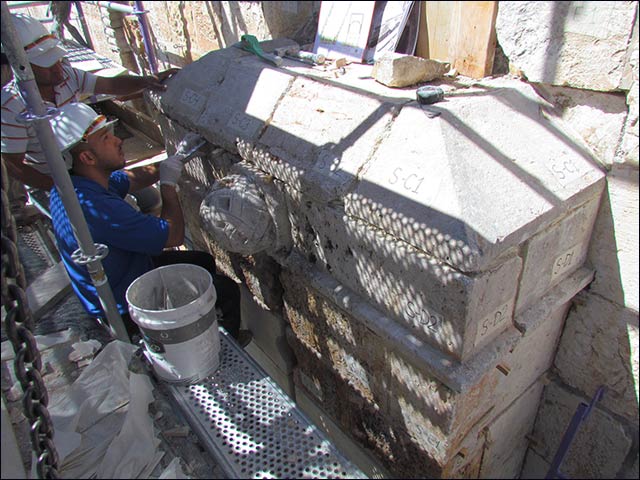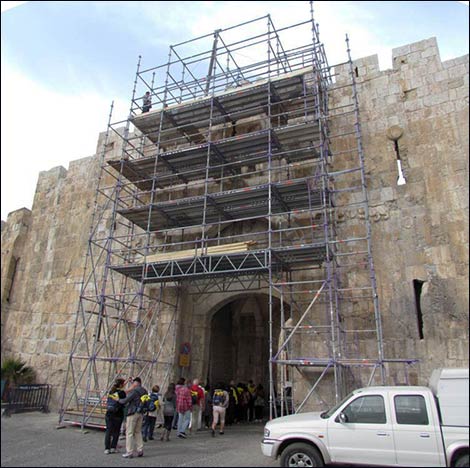(Communicated by the IAA Spokesperson)
The work of preserving and stabilizing the Lions Gate in the Old City’s eastern wall has been completed. This impressive gate is the last of the seven open gates of the city wall that were meticulously and professionally treated in recent years by the Conservation Department of the
Israel Antiquities Authority. This was done within the framework of the comprehensive project of conserving and rehabilitating the Old City walls, at the initiative of and with funding provided by the
Jerusalem Development Authority and the
Prime Minister’s Office.
At the start of the conservation work on the Lions Gate the project engineers discovered that the sentry’s post situated above the gate’s entrance, which was where the soldier guarding the tower once stood, was in danger of collapse. The sentry’s post was entirely dismantled, broken stones in it were replaced and it was returned and secured to its original place on the wall. The two lions carved on either side of the gate also underwent conservation and cleaning.

Conservation work at the Lions Gate
Photo: Avi Mashiah, courtesy of the Israel Antiquities Authority
Within the framework of the conservation work carried out on the Old City walls in Jerusalem, which lasted five years, the walls were conserved which had been built and renovated in the mid-sixteenth century by the Ottoman Sultan Suleiman I. Both sides of the wall were treated for a total distance of c. 3,800 m. Each and every one of the stones in the wall was photographed with a laser, documented and studied. Approximately 1,000 deteriorating stones were stabilized; c. 2,000 square meters at the top of the wall were stabilized and sealed to prevent the penetration of water; c. 350 merlons and embrasures were conserved and the stone work in them was completed; c. 2,000 square meters of stones in the wall were dismantled and rebuilt due to vegetation that had taken root in them and a total of c. 5,000 square meters of the walls’ surface were cleaned.
According to Aner Ozeri, the official in charge of the Old City at the Jerusalem Development Authority, “The walls were cleaned and stabilized for the visitors to the city while maintaining their authenticity and original appearance. We will continue working to improve the appearance of the Old City and its preservation”.
According to Mr. Ra’anan Kislev, director of the Israel Antiquities Authority Conservation Department, “We are happy and proud to complete the flagship conservation and rehabilitation project of Jerusalem’s Old City walls. The project is one of the most complicated, largest and important ever conducted in the country and the best professionals of the Conservation Department – architects, conservators and engineers – were involved. Now that we have removed all of the soot and vegetation, the safety hazards presented by the deteriorating stone have been treated and the structural components have been restored, the visiting public to Jerusalem can enjoy the splendor and strength of the walls, just as people enjoyed them when the walls were built five hundred years ago”. Kislev added, “It is important to continue and maintain the city walls after the conclusion of the project in order to preserve and display for years to come one of the most important monuments in Jerusalem”.

Photo: Avi Mashiah, courtesy of the Israel Antiquities Authority
The Jerusalem Development Authority continues its work to conserve, rehabilitate and develop the Old City as the leading tourism site in Israel and to increase the amount of visitors and tourists to it both in the daytime and at night.